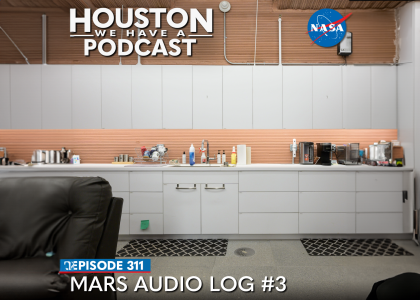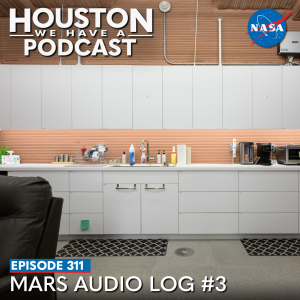
From Earth orbit to the Moon and Mars, explore the world of human spaceflight with NASA each week on the official podcast of the Johnson Space Center in Houston, Texas. Listen to in-depth conversations with the astronauts, scientists and engineers who make it possible.
On episode 311, the CHAPEA crew gives an update in their third month of a one-year stay in a simulated Mars habitat, and Dr. Scott Smith discusses the crew’s nutritional needs for the analog mission. This is the third audio log of a monthly series. Recordings were sent from the CHAPEA crew throughout September 2023. The conversation with Dr. Smith was recorded October 4, 2023.

Transcript
Host (Gary Jordan): Houston, we have a podcast! Welcome to the official podcast of the NASA Johnson Space Center, Episode 311, “Mars Audio Log #3.” I’m Gary Jordan, I’ll be your host today. On this podcast, we bring in the experts, scientists, engineers, astronauts, all to let you know what’s going on in the world of human spaceflight and more. We’re back with another audio log from the CHAPEA crew. CHAPEA, or Crew Health and Performance Exploration Analog, is a year-long analog study in a habitat here right on Earth that is simulating very closely what it would be like to live on Mars. We’re lucky enough to have monthly check-ins with the crew Commander Kelly Haston; Flight Engineer, Ross Brockwell; Medical Officer, Nathan Jones; and Science Officer, Anca Selariu. To meet the needs of fitting in with this analog and simulating significant communication delays between Earth and Mars that prohibit us from having a live conversation, the crew is recording an audio log based on questions that we draft for them. On this episode, we’ll play the recording of their third month in the habitat, which is here at the NASA Johnson Space Center, and was recorded in September 2023.
We’ll also be bringing on a special guest to learn even more about CHAPEA. If you’ve been tuning into these logs, you know that they talk a lot about food. One of the scientific objectives of this analog is better understanding a Mars food system, but there are many layers to that. One layer is nutrition, and one of the scientists looking for data of this particular mission is Dr. Scott Smith, NASA nutritionist, CHAPEA co-investigator, and manager of nutritional biochemistry here at the Johnson Space Center. So with that, let’s learn from the CHAPEA crew on how they’re doing and Scott Smith on the CHAPEA nutrition science. Let’s get into it.
[Music]
Host: Alright, first is CHAPEA Mission Commander, Kelly Haston.
Kelly Haston: Hi, my name is Kelly Haston. I’m the commander of CHAPEA 1, a one-year-long Mars analog mission out of Johnson Space Center in Houston. A lot of people ask us how things are going in here in particular as we’re now at day 85 of a 378-day-long mission. And to be honest, they’re actually going really, really well. So well that I think we’ve taken even our colleagues outside of the habitat by surprise. So the crew is actually in tremendously good spirits and really just moving along really well, having set a really great pace for ourselves. So really, really happy and settled in here in our habitat and doing great for the mission so far.
A lot of people also ask what kind of highlights or activities we do in particular in the last month. So, as I mentioned, we’re in day 85, so we’re at about two and a half months right now. And this month was a lot more about repeating things. So what we’re actually doing now is moving through activities that we’ve already experienced, but doing them for the second, or in some cases even third or fourth time. So we’re really honing in on how to actually do them really well. And I think that one of the highlights of all of that is that the crew has gotten even more efficient at performing our activities and our tasks. So we’re really getting things done quickly right now, and we’re really enjoying sort of getting to know each other’s styles even better. And just really knowing how to communicate on difficult tasks such as an EVA, where you might be outside on the Martian surface and have to be walked through a really complex technical sort of challenge, like building something without any directions—visual directions—and your inside, you know, mission control person is basically helping you walk through the steps and telling you what to do. So that’s actually been really great to know what a colleague is actually trying to tell you sight unseen at times. So that’s been really, really fun.
Kelly Haston: But having said that, because we’re actually starting to repeat things, we are really settling into routine and I confessed that in August, I thought we were settling into a routine, but now that we’re in September, I really do realize that, you know, we’re getting into this long haul. I’m an ultra-runner and it’s truly an ultra-experience where you really have to settle in and make sure that you’re taking care of yourself and really checking boxes and making sure that everything is taken care of because we’re really starting to see that settling in of “we’re going to be here for quite a while still.” We still have many months left of the mission. So everyone’s just getting really, you know, cemented into their process. The team has really good process now, and as I said, we’re just really efficient and really enjoying that and really thriving on it in, in my opinion.
We have had a lot of sort of fun things happen. And probably the fun fact that I really like to think about living on Mars that I would want to share with people on Earth is the fact that, as I mentioned, we do these EVAs, or extravehicular activities, and to be honest, they’re really fun for the most part and satisfies that urge to get outside because we are inside our habitat all the time otherwise. So I surprised someone recently by actually saying that when I go outside, in particular in virtual reality, which is a truly beautiful setting that has been built for us to mimic the sense of being on Mars and actually walking and doing different tasks on Mars, when I do have a down moment, I often spend time looking at the Sun in virtual reality. And that Sun from the surface of Mars really sort of just gives me a sense of peace and, and wonderment at where I am at. And even though it’s virtual reality and I know that, I think that that’s actually one of my fun facts is how much sort of I take from going outside of our habitat and doing these things even though we’re still in a confined space and not seeing other, other people other than the crew. So my fun fact is actually that I actually apparently really love being on Mars.
Kelly Haston: That being said, I really miss Earth and certain aspects of Earth. So I really miss my partner, my family, and my friends, and they’ve been really tremendous at keeping me in contact with them through email, video, audio recordings. But you can’t really help but miss the people the most, you know, there’s things that you might miss or being, you know, doing certain things, eating certain things, but to be honest, it’s really the people that I yearn for when I’m, you know, having a day where I just really would like to see somebody and my partner pops out of course. And also my family, who I miss a lot and think about a lot and worry about a lot. So that’s probably the thing that I would miss the most.
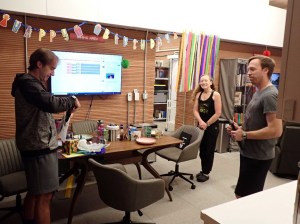
Interestingly, I’m not missing the outdoors or food a terrible amount. And again, maybe that’s because that setting that we have that we go to to perform our tasks outside is, is really sufficient right now for my sense of wellbeing. But we’ve also had some really special activities this month. So we actually had two crew birthdays in September already within a week of each other. So the crew spent some time leading up to the first birthday decorating the habitat with some special decorations that had been left for us by the outside crew before the mission started. And so we were able to put up some special things and they also gave us a birthday cake kit. So we had a space pound cake that we were allowed to dress up. So that was actually a really special event for both people. Each night we had a special meal and it was just really nice to celebrate and give gifts to one of your crew mates. And I think everybody just really enjoyed those evenings. And then afterward we either like played a game or watched a special show together. But I would say that that felt really, really nice to be celebrated. I was one of the birthdays, so to be celebrated by my crew mates, but also get the opportunity to celebrate one of our crew mates and really make a special night for them was fantastic.
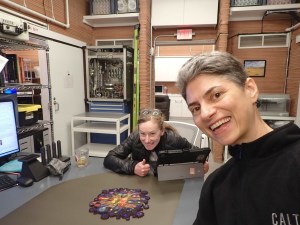
Kelly Haston: Coming up in the next month or so, we’re expecting to get our crops fairly soon and I think that the crew is tremendously excited about fresh food, but also about growing things. And I think the growing things actually even outweigh the fresh food cause most of us are doing pretty well eating the food that is provided, which is very good. But the idea of being able to grow something tend to something, you know, sort of have it as something that you give care to, that’s I think going to be very exciting. And also to see them grow and to be able to harvest them and, and really see how that augments our diet. I think we’re really excited about that. On top of that, we have many other really cool tasks that we either know a little bit about or will be a surprise to us, but we’re really enjoying all of our activities and we’re looking forward to that opportunity to grow food within our environment as well. So everything’s great here in Dune Alpha and the crew of CHAPEA 1 is doing fantastic. Thank you again for your interest.
Host: Alright, that was Commander Kelly Haston kicking us off. Very interesting to hear her experience. I found it particularly interesting that she was talking about being here on Mars and talking about people of Earth. Her perspective of, you know, just being in there for, she mentioned, two and a half months, very sold on being a part of the CHAPEA mission. So very, very cool to hear. She mentioned some of the crops that are coming. We hope to have a special guest to help us to talk more about that. But part of the food complement for the CHAPEA mission is of course their prepackaged and pre-delivered food. But they’ll also have a chance to grow and eat some of the food. And of course that’s part of the CHAPEA mission. So we have to hoping to have a guest to talk more about that particular system later. Again, in this episode we’ll be talking with Scott Smith, the NASA nutritionist about some of the food that’s already there and of course analyzing the food, the total food complement of the CHAPEA mission. And of course I think the last thing is happy birthday to Kelly Haston who just celebrated it this past month. Okay, next is CHAPEA mission Flight Engineer, Ross Brockwell.
Ross Brockwell: Hello, this is Ross Brockwell. I’m the flight engineer on CHAPEA Mission 1 answering a few questions as an update on our mission from Houston We Have a Podcast. So first question, “how’s everything going?” It’s going great, really. You know, sometimes we look at the numbers and it seems like a long way to go but weeks are flying by, things are going great. We’re managing to have a pretty good time I think, and getting a lot done.
“Tell us about some of the highlights of the activities and tasks over the last month.” Well the trips outside, the EVAs, are always fun. Almost always fun. So both the real world and the VR EVAs, they’re great. They’re really interesting. Exploring the surface is really amazing. Then September we’ve had two birthdays actually, so we decorated the hab a bit and had a couple parties, a couple special meals, so that’s been great too.
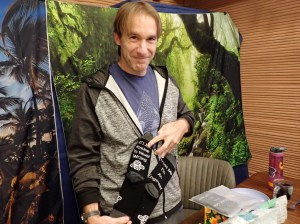
“Do you find yourself in a routine more or less?” Yeah, more or less. You know, the days are pretty well scheduled, so all of our activities are lined up. But things stay pretty well mixed up with the science and the maintenance and the training and the fitness and all the other things we have to do. You know, we have some free time for some fun or our personal projects as well.
Ross Brockwell: “Name one fun fact about living on Mars that you’d like the people of Earth to know.” So I was thinking about what to say to this and I thought I might talk a bit about the communication delay. So, you know, with the millions, hundreds of millions of miles between Earth and Mars, there’s a communication delay and that’s being simulated in this mission. But it’s not really that simple because it’s really an information queue. So your communications are sent and they take something like 20 minutes to travel, but the data has a data stream that’s limited. So there’s a queue of information. And so what you might think is a 20-minute delay can sometimes be much longer if there are large packets of information that have to go back and forth. So it varies a lot. So it’s at least 20 minutes, but you have to be pretty strategic about what you send and when, because certain messages need priority and certain pieces of data need a long time to be sent. So the communication delay is really interesting part of the mission that we’re learning a lot about.
Ross Brockwell: “Is there anything from Earth that I’m especially missing this month?” Well, mine was one of those birthdays, so yeah, I miss my loved ones of course. And I’m also missing sunshine and the ocean and exercise outside. You know, I miss Earth.
“Any special crew bonding activities?” Yeah, there’s a few shows we’ve kind of gotten into together. We have a pretty good library, so we’re watching some things together and we have an ongoing poker game that’s been a lot of fun. We have a few video games we share, so we either kind of play them together, taking turns or there’s a couple of things we have we can actually play together simultaneously. So it’s been a lot of fun. And there are a few books that we’re all reading in turn, so we discuss them and, you know, plans and discussions around that. So that’s been good. “What’s coming up in the next month?” So there will be more of the same, but we do have some drone stuff this month. It’s always fun. We’re looking forward to that. There’ll be a few more EVAs and you know, maybe some surprises, so we’ll see. Alright, well thanks a lot.

Host: Again, that was Ross Brockwell, the flight engineer for CHAPEA. He mentioned a couple of things. One of them was that time delay. Very interesting thing to consider. They’re simulating it, of course. The CHAPEA habitat is here at the Johnson Space Center, but part of the system for communicating with the flight control teams, which actually are positioned right outside of the habitat, they build in these communications delays. So it’s very interesting to hear some things that they have to consider that maybe we just wouldn’t in our day-to-day lives just working on a computer here on Earth, how big of a file is the thing you want to send and considering how long it’s going to actually take to send it, how many you have to queue, and how many of those files you want to send at a time. All things to consider as part of the workload that is part of the CHAPEA mission. And I think we just found our other birthday, happy birthday to Ross Brockwell. Okay. The last two crew members recorded their audio log together, but first we’re going to speak with Scott Smith about the nutrition science of CHAPEA.
Scott Smith, thank you so much for coming back on Houston We Have a Podcast.
Scott Smith: Sure thing. Glad to be here.
Host: Hey, I’m glad to be able to be speaking with you. We had you on for Episode 43 back in 2018. I happen to be out town that time. So we had Dan Hewitt, who did the interview with you. And we’ve asked him a couple of times cause we do these anniversary episodes every year, we kind of reflect on the year before. Multiple years in a row, he mentioned that you were his favorite interview. It’s a very good episode, but I appreciate you coming on again to talk about CHAPEA.
Scott Smith: Thank you.
Host: Just because it was so long ago, 2018, you kind of described NASA nutrition, biochemistry, what you do here at NASA. Just to refresh our listeners, can you talk about, what your role is here at NASA?
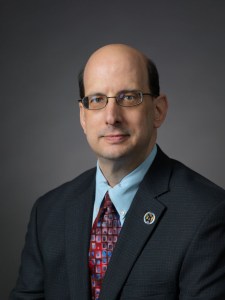
Scott Smith: Well, again, I’m happy to be here and I appreciate the invitation. So I work in what we call the Nutritional Biochemistry Lab. And what that means is that we do nutrition. We are not the Food Lab. We don’t do anything with the tang or the food or anything like that. We do nutrition. So our job is to understand the nutritional requirements and what astronauts need while they’re up in space. Everything from energy, protein, carbohydrates, vitamins, minerals, you name it. Trying to understand what needs to be in the food that they eat, and then we also look at the actual crew members, what they’re eating and their physiological outcomes when they get back. So are they eating enough? They’re maintaining their weight. Are there bone loss issues or muscle loss issues that have nutrition components that we can help to keep them healthier?
Then we do research to try to understand how we can use nutrition as a way to mitigate some of the negative effects of spaceflight. I’m obviously a nutritionist. I’m a very biased one, and I will tell you that every system in your body that you like depends upon nutrition. So if you’re worried about your bones or your muscles or your heart or your nervous system or your sleep or your interactions with other people, all those things depend upon nutrition. So we consider nutrition a cross-cutting science, and we dabble a little bit in all of those elements with astronauts, trying to keep them healthy.
Host: Right. And I know a lot of your work in most recent years has been with International Space Station, so your interfaces with the crew, right? You’re understanding their needs, you’re studying them, obviously they’re the ones that are the recipients of the nutrition. You’re working with the food scientists to make recommendations based on nutrition. So you’re working kind of across the different programs, different stakeholders, to try to find the right complement of nutrition?
Scott Smith: Absolutely. And yes, right now most of our work is with station crews. We do a nutritional assessment profile on the station crews that before and after flight we collect blood and urine and look at their nutritional status to make sure we send them up as healthy as can be. And that when they come back, if there’s any issues, we help work with the rehabilitation team to get them back to full health as quickly as possible. But we’re also working with the Artemis programs to look at food and nutrition requirements for what we’re going to feed those folks. And then we’re also looking toward Mars of what do we need to do from a food and nutrition point of view to keep crews healthy on those ultimate missions.
Host: Right. Yeah. You’re thinking ahead and you’ve been doing just the station stuff for quite some time. I mean, we’re recording this now during Expedition 70. Would you say that the nutritional complement is more or less the same or have you been tweaking things over the years?
Scott Smith: I don’t know about tweaking, but there have been changes over the years. The food system we’re feeding folks right now is better than it used to be. Around 10 years ago, there was a push to reduce the sodium content of the food. And they reformulated I think almost everything and dropped the sodium content of the food system by about 40% so that we went from feeding folks too much sodium to a decent amount of sodium. We’re also working in recent years with the Foods Lab to augment the food system and make it even better. So get more fruits and vegetables in there, more sources of Omega-3 fatty acids, like fish, and other foods to try to make it healthier.
So the food we’re providing crews is better today than it was in 2000. And to a degree, I think the mentality of the astronauts has changed a little bit over the years. And I think we’re seeing generational shifts, and crews these days are more attuned with the fact that nutrition’s important for health and come in looking for ways that they can use nutrition to maintain their health on Earth, and then maintain and do the same thing during flight.
Host: Got astronauts who are on board, who are willing to work with you very closely. That’s awesome.
Scott Smith: Exactly.
Host: Now we’re going to be talking about CHAPEA of course, but just to stay on station for one more moment is to really kind of understand the differences, right? Thinking about what we have and what we do for nutrition on the International Space Station, why is CHAPEA, this analog, helping us better to understand that food complement rather than just sticking with the International Space Station? You and I were chatting a little bit before this, there is something that is unique with CHAPEA that allows you to have a better understanding of deep space missions.
Scott Smith: Absolutely. And in my mind, the genesis of CHAPEA goes back around six years ago and the space station program came to the scientific community and said that they were looking for ways to use station as a Mars simulation. So what could we do on station that would help simulate Mars? And the Foods Lab, Grace in particular, Grace Douglas said, “look, there’s two things about station that are very unique.” One is the crews get to pick about 20% of the foods—what we call crew-specific menu—where the 80% of what they eat is fixed and everybody eats from the same containers of food. But that each person gets to pick 20% of the food, things that they like, things that they want, things that they want more of than are in the typical food system. And that’s a big deal. The other thing is that every time a vehicle goes up to station—a cargo vehicle, a crew vehicle, you name it—they will put in fresh fruits and vegetables. Things like oranges, apples, tomatoes. I know the Russians have flown onions in the past. Lots of things like that. Berries, peppers, you name it. They don’t last very long. There’s not a lot of them, but the psychological part that comes along with those is huge. And as I say, the happiest pictures of astronauts you ever see are with those things floating in front of them.
[Laughs]
Host: That’s what we use for the thumbnail of (episode) 43, by the way. All the fruits and vegetables floating in front of Kjell Lindgren. Yeah, exactly.
Scott Smith: And there’s a picture of that hanging on the wall outside my office. So Grace and team went to the station program and said, “okay, you want to simulate tomorrow’s mission, take those two things away.” And the station program said, “yeah, we’re not going to do that.” Which in short tells you just how important those things are. That psychologically for the crew, those things are huge. So from that was born CHAPEA, the idea of how do we simulate a Mars surface mission and what do we feed the crew? So again, Grace led the effort to work from there, to get support from there, to build a habitat that we would put crews in for a year and we would feed them space food and see if we could overcome the challenges of a truly closed food system, as we call it, where the food is all there and you just need to eat it. How do we overcome things like menu boredom? How do we make sure crews are getting enough nutrition, maintaining their body weight, maintaining their nutritional status, working well together and not getting angry with each other? Again, all of that is affected by dietary intake and food and nutrition.
Host: Fascinating. So when you’re investigating this and when you’re thinking about it, you mentioned a couple of things in there, but when you look at it from a scientific perspective, are you analyzing it purely from a nutritional perspective? Or are you taking a look at some of those psychological impacts because maybe they’re more related than people might realize?
Scott Smith: Well, the knothole that we look through is simply nutrition. But obviously, CHAPEA is a multi-investigative project. In the end, the data from all those elements will be integrated together. So we’ll look at exercise performance, we’ll look at EVA performance, we’ll look at behavioral performance in light of what was their nutritional status? Did they maintain their body mass? All those things will go into a big statistical evaluation of how things fit. But again, I’m a very biased nutritionist, so the food and nutrition element is obviously the most important one.
Host: Right. If you take those elements out when you’re focusing on a CHAPEA mission, no fresh deliveries in the middle of a mission and a standard food system, not a lot. You said 20% is what they have on station, which is their choice? So when you take those things away, what are you interested at finding? Are you thinking, is this enough from a nutritional perspective? Is that really what you’re looking at?
Scott Smith: Well, there’s a few elements to the way CHAPEA is laid out. But the food system or the foods that are available to the crew are fixed, and they need to keep track of that. They need to make sure they don’t overeat and run out of food. And we need to make sure that they’re eating enough, period. So that really is one of the key elements that we’re looking at. We get the dietary intake reports that they’re recording, all their intake, in an Excel spreadsheet. It’s a specialized spreadsheet that they can track all the foods and when they ate them and we have one of our dieticians working on that every week. Generates a report of each crew member’s dietary intake every day, macronutrients, micronutrients. We provide that over to Grace to evaluate how things are going along the way. And then from the other perspective, once a month, we collect blood samples, we collect urine samples and we’ll look at again, vitamin status, mineral status, kidney stone risk, all different elements of what’s going on with their bodies and their nutrition.
Host: Okay. So you said the dietician is working with that on a weekly basis with the receiving that data. As part of CHAPEA, as part of this analog, is it passive? You’re just receiving and analyzing data? Or is there a two-way street where the dietician can provide some feedback that says, “hey, you need to maybe have a little more, you know, vitamin C this week,” or something like that?
Scott Smith: We do provide some feedback. But that typically is managed through Grace. So we provide a report to Grace of the body weight data and the dietary intake data, and then she sends a report into the crew, I believe once a week that gives them suggestions of, “hey, you may want to look at this, or you may want to focus on that.” We don’t tend to get down into the weeds I would call it, of things like vitamin C. We’re at this point operationally working at a bigger level. Are you getting enough calories? Are you getting enough fluids? Are you getting enough calcium? Are you getting enough potassium, some of the major nutrients? Trying to tweak some of these intake down to some of the, what I call, micronutrients, is really challenging to do.
Host: Do you think having regular, constant, continuous operations on the space station has helped you refine a food system to a point where you can bring it to CHAPEA and go into it with a certain level of confidence that this may be right for a Mars mission? Or maybe there’s a lot more learning than I’m expecting?
Scott Smith: Well, the food system we’re using at CHAPEA is the best of the space station foods. And we’ve made some changes. We’ve worked with our colleagues in the Foods Lab to make the food system better on station. And those changes have taken place over the last couple of years. Again, in basic sense, more fruits and vegetables and more fish sources. The food system we’re using in CHAPEA is as good as we’ve got right now. Could we send a crew to Mars with that? No, we couldn’t because the shelf life of those foods won’t support the mission scenarios that we’re laying out for Mars right now.
The reality is the plan at this point is that we will send food to Mars before the crew leaves Earth for essentially the back half of that mission. So the expectation at this point is that the food system, the foods, have to have a five-year shelf life, even though the mission will be two and a half to three years. So think about filling up your pantry for foods you’re going to want to eat in five years. It’s a tough task.
[Laughs]
Host : Yeah cause you have to think about there’s also that psychological component too of just wanting to eat it. You don’t want to get sick of this stuff.
Scott Smith: Exactly. The other comment I would make is that we’ve used what we’ve learned on station to apply to how to do it in CHAPEA. The other thing is we do the same thing on station that we’re doing with CHAPEA, which is we get a record every week of what the crew is eating. We provide a report to the flight surgeon, and then we rely on the flight surgeon to work with a crew of saying, “look, hey, you’re not getting enough calories, you’re not getting enough fluid, you’re not getting enough calcium.” So we do support operationally the same way on station as we do in CHAPEA.
Host: Right. With the feedback on nutrition. Just to sort of bring it home is thinking about CHAPEA, right. And giving you one of the things that’s different is the space station has helped us refine a food system so we’re just constantly learning and adding new things. But CHAPEA is that next step to better understanding the food system for a Mars mission. From your perspective as a nutritionist, why is CHAPEA and missions like it so important and to have to give us better data for understanding deep space missions?
Scott Smith: Well, in my mind, CHAPEA is the first major step we’ve taken from a food and nutrition point of view towards actually enabling Mars missions. What we will find is that important. It may not be the be all end all, but without CHAPEA, I think we’d have a lot more trouble and a lot more risk than sending crews off to Mars. We will learn a lot from these missions that will help to enable those next steps.
Host: Do you think everything we’ve done on station and the things we’re doing with CHAPEA, learning about deep space, do you think understanding that helps us to just our daily nutrition?
Scott Smith: Absolutely. And indeed, every element of what we do in the space program provides some education towards how the body changes, how nutritional requirements are different and building from ground analogs like bedrest or Antarctic missions or station missions, or CHAPEA missions, all of that information provides us steps towards a Mars mission. And likewise, I always maintain that everything we’re doing for the space program in one way or other, has implications for people on Earth. One example that I always like to throw to is we did studies in Antarctica looking at vitamin D supplementation, and not only did those studies impact the vitamin D supplements we give to station crews, but those studies were among the many cited when they redesigned the vitamin D requirement requirements for people on Earth. When the Institute of Medicine in Washington established Vitamin D requirements for North America, our paper was one of the ones they cited.
A paper we published recently looked at the blood biochemistry and relationship and effects on blood clot risk in astronauts. And one of the highlights that we maintained in that paper is that we highlighted an underappreciated risk for blood clots that has implications for the almost, I think it was 800,000 people a year, that developed blood clots. So pushing medicine, pushing general nutrition, what we do is very unique. It often seems, you know, that we’re doing a lot of work to help the handful of people off the planet, but really it helps to inform the greater medical and scientific communities and pushes all those things forward.
Host: Scott, I can’t think of a better way to end just wrapping it up with everything we’ve done to understand the food system, everything we’re doing for deep space missions and how it helps all of us on Earth. Scott Smith, thank you so much for coming back on Houston We Have a Podcast. It was a pleasure to have you.
Scott Smith: Thanks. I appreciate it.
Host: Okay. That was Scott Smith. Now last but not least, the last two crew members recorded their experience together. Here is Medical Officer, Nathan Jones sand Science Officer, Anca Selariu.
Nathan Jones: Hello, my name is Nathan Jones. I’m the medical officer for the CHAPEA 1 Mission.
Anca Selariu: Hi, my name is Anca Selariu. I am science officer for CHAPEA Mission 1.
Nathan Jones: We were asked to answer a few questions. The first one is, how is everything going? Anca?
Anca Selariu: We are fantastically still on Mars, and we’re happy about it. Everything is going as well as can be hoped. How about, Nate, you tell us some of the highlights of the activities and tasks of the past month.
Nathan Jones: Yeah, so some of the highlights for me, we had a couple of birthdays to celebrate this current month. And those were fun. And we got to decorate some pre-made cakes and with some frosting or icing, made some cards, blew out an electronic candle and sang Happy Birthday.
Anca Selariu: Offkey.
[Laughs]
Nathan Jones: Beggars can’t be choosers.
Anca Selariu: I know.
Nathan Jones: Anca, did you find yourself in a routine more or less?
Anca Selariu: I find myself in whatever routine NASA has us be in, and that pretty much involves a morning, wake up with morning measures, and I will probably never live another day without weighing myself in the morning.
Nathan Jones: Yeah, one week is what we call “testing week.” And we have a lot of different testing that goes on that week, whether it’s regarding our physical levels, cognition testing, blood work, those sorts of things. The next week, we would have virtual reality EVA or spacewalk week, and then another week it would be non-virtual reality EVA week. Next question is “name one fun fact about living on Mars that you’d like the people on Earth to know.”
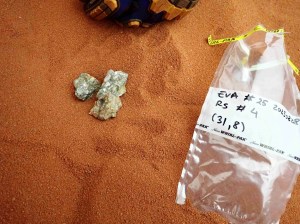
Anca Selariu: One fun fact is that the colors outside are very different from the colors you would normally get looking out the window on Earth.
Nathan Jones: For me, I’d say, and this was kind of told to us before we come in by one of the astronauts, but I think the thing is life goes on for everyone on Earth, and for us it kind of feels like we’re in a time loop or some sort of thing where we’re stuck in the same point in time. To me, it still feels like it’s June 2023, the day we came in.
Anca Selariu: I guess you’re right. Pretty much the same for me. Is there anything from Earth that you especially missed this month?
Nathan Jones: Just mostly the same things. My family primarily, certain foods, I think. Among the crew, many of us said we are missing chips. Crunchy things like that. And you know, I’m also missing my work a little bit.
Anca Selariu: I miss plain yogurt and I desperately missed driving. I had a full dream about driving cross country. It was amazing.
[Laughs]
Nathan Jones: When you say plain yogurt, are we talking about yogurt with no sugar or anything? Just, I mean—
Anca Selariu: Yes, just plain Greek yogurt, yeah.
Nathan Jones: Maybe we can find some yeast up here and make some for you. Any special crew bonding activities, either routine item or a single experience?
Anca Selariu: Okay. We are especially fond of watching special TV series together and playing games every now and then. I don’t know of single experiences.
Nathan Jones: We had an origami night. Anca here made some beautiful flowers for one of our crew members who had a birthday this month. We’ve played some card games. I’m not sure if you mentioned that one. I guess that’s mostly—oh, drawing, those kinds of things. Oh, basketball, we had a basketball game.
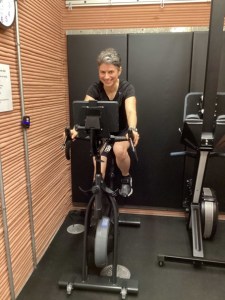
Anca Selariu: Yes. I finally learned how to play a proper tournament and then it was gone. Nate, what’s coming up in the next month that you’re excited about?
Nathan Jones: Well, we were told before the mission that we should be seeing some crops during October. And so that’s something that we’re looking forward to growing some food of our own that will be fresh, hopefully. And we’re hoping to get that basketball hoop backup, working. Yeah.
Anca Selariu: I completely agree. And not to mention as always, EVAs.
Nathan Jones: Yeah. That and I think we all tend to like the drone and rover missions that we look forward to as well.
Anca Selariu: Yes, yes, yes. Okay, well thank you for being with us and still being interested in our fun activities on Mars. And hopefully we get to talk to you soon again.
Nathan Jones: Yes. Thank you everyone at home for your interest in our mission and support.
[Music]
Host: Alright, and that’s it for the audio logs for Audio Log #3 from Alpha Dune. It was awesome to hear Nathan and Anca play off of each other, but also great to hear from all of the crew members inside CHAPEA and of course from our special guest. Thanks for sticking around. I hope you’re enjoying the crew’s journey and hearing these audio logs every month. This is the third audio log in our series, and again, we’re doing this every month. Check in next month for Audio Log #4. You could check nasa.gov for the latest and nasa.gov/podcasts for all the different podcasts we have across the agency, including ours. You can listen to any of our episodes in no particular order except these, you should probably listen to them in order, the audio logs. Social media, you can check us out on the Johnson Space Center pages of Facebook, X, and Instagram using #AskNASA on your favorite platform to submit an idea for the show, just make sure to mention is for Houston We Have a Podcast.
Recordings were sent from the CHAPEA crew through September, and we had the conversation with Scott Smith on October 4, 2023. Thanks to Will Flato, Dane Turner, Abby Graf, Jaden Jennings, and Anna Schneider. Thanks to Scott Smith for taking the time to come on the show. And a big thanks to Kelly Haston, Ross Brockwell, Nathan Jones and Anca Selariu for sharing their experience for this audience on Houston We Have a Podcast. Give us a rating and feedback on whatever platform you’re listening to us on and tell us what you think of our podcast. We’ll be back next week.


























